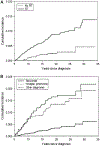Secondary sarcomas in childhood cancer survivors: a report from the Childhood Cancer Survivor Study
- PMID: 17312307
- PMCID: PMC10536686
- DOI: 10.1093/jnci/djk052
Secondary sarcomas in childhood cancer survivors: a report from the Childhood Cancer Survivor Study
Abstract
Background: Childhood cancer survivors are at increased risk for the development of secondary sarcomas. Exposure to radiation therapy is a known risk factor for the development of these sarcomas. Other risk factors for secondary sarcomas have not been well described for childhood cancer survivors. We analyzed a large cohort of childhood cancer survivors to determine the true incidence of secondary sarcomas and to examine factors associated with the risk of developing secondary sarcomas.
Methods: The history of secondary sarcomas in 14,372 participants in the Childhood Cancer Survivor Study was determined from self-reports in three questionnaires. Risk of secondary sarcoma was evaluated by use of standardized incidence ratios (SIRs) and excess absolute risks (EARs) as calculated by use of data from the Surveillance, Epidemiology, and End Results Program. Cox regression models were used to estimate hazard ratios of developing subsequent sarcomas. Hazard ratios were reported as relative risks (RRs).
Results: We identified 108 patients with sarcomas that were diagnosed a median of 11 years after the diagnosis of childhood cancer. The risk of sarcoma was more than ninefold higher among childhood cancer survivors than among the general population (SIR = 9.02, 95% confidence interval [CI] = 7.44 to 10.93). The excess absolute risk of secondary sarcoma was 32.5 per 100,000 person-years (95% CI = 26.1 to 40.3 per 100,000 person-years). Higher standardized incidence ratios and excess absolute risks were associated with young age at primary diagnosis, primary sarcoma diagnosis, and a family history of cancer. In a multivariable model, increased risk of secondary sarcoma was associated with radiation therapy (RR = 3.1, 95% CI = 1.5 to 6.2), with a primary diagnosis of sarcoma (RR = 10.1, 95% CI = 4.7 to 21.8), with a history of other secondary neoplasms (RR = 2.2, 95% CI = 1.1 to 4.5), and with treatment with higher doses of anthracyclines (RR = 2.3, 95% CI = 1.2 to 4.3) or alkylating agents (RR = 2.2, 95% CI = 1.1 to 4.6).
Conclusion: Childhood cancer survivors appear to be at increased risk for secondary sarcomas compared with general population rates.
Figures

References
-
- Dreyer Z, Blatt J, Bleyer A. Late effects of childhood cancer and its treatment. In: Pizzo P, Poplack D, editors. Principles and practice of pediatric oncology. 4th ed. Philadelphia (PA): Lippincott Williams & Wilkins; 2002. p. 1431–62.
-
- Greenlee RT, Murray T, Bolden S, Wingo PA. Cancer statistics, 2000. CA Cancer J Clin 2000;50:7–33. - PubMed
Publication types
MeSH terms
Substances
Grants and funding
LinkOut - more resources
Full Text Sources
Medical

